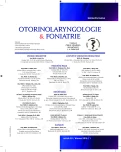Drug-Induced-Sleep-Endoscopy, DISE
Authors:
J. Hybášková 1; V. Babiarová 1; O. Jor 3; V. Novák 4; P. Matoušek 1,2; Pavel Komínek 1,2
Authors‘ workplace:
Klinika otorinolaryngologie a chirurgie hlavy a krku, Fakultní nemocnice Ostrava, přednosta prof. MUDr. P. Komínek, Ph. D., MBA
1; Lékařská fakulta, Katedra kraniofaciálních oborů, Ostravská univerzita, vedoucí katedry prof. MUDr. P. Komínek, Ph. D., MBA
2; Klinika anesteziologie, resuscitace a intenzivní medicíny, Fakultní nemocnice Ostrava, přednosta prof. MUDr. P. Ševčík, CSc.
3; Centrum pro poruchy spánku a bdění – spánková laboratoř, Klinika dětské neurologie, Fakultní nemocnice Ostrava, primářka MUDr. H. Medřická
4
Published in:
Otorinolaryngol Foniatr, 65, 2016, No. 1, pp. 30-34.
Category:
Review Article
Overview
Obstructive sleep apnea (OSA) is characterized by repetitive pauses in breathing during sleep, despite the effort to breathe and is caused by obstruction of the upper respiratory tract. Diagnostic and therapeutic challenge is to determine the location, which leads to obstruction of the upper airway. DISE has been used commonly in recent years in the Europe. DISE is the safe, well-performed method that facilitates the localization of snoring and obstruction via a flexible nasopharyngoscopy during pharmacologically induced sleep. A great benefit of this method is the individual analysis the upper airway and targeted therapy according to the location and degree of obstruction of the upper airway and thus higher treatment success in patients with snoring and OSA.
Keywords:
drug induced sleep endoscopy, obstructive sleep apnea, flexible endoscopy
Sources
1. Aktas, O., Erdur, O., Cirik, A. A. et al.: The role of drug-induced sleep endoscopy in surgical planning for obstructive sleep apnea syndrome, European Archives of Oto-Rhino-Laryngology [online]. 2014, 272(8): 2039-2043 [cit. 2015-09-12]. DOI: 10.1007/s00405-014-3162-8.
2. Campanini, A., Danti, P., De Vito, A. et al.: Awake versus sleep endoscopy: personal experience in 250 OSAHS patiens. Acta Otorhinolaryngologica Italica, 30, 2010, s. 73-77.
3. Cavaliere, M., Russo, F., Iemma, M.: Awake versus drug-induced sleep endoscopy: evaluation od airway obstruction in obstructive sleep apnea/hypoponoea syndrome. Laryngoscope, 123, 2013, s. 2315-2318.
4. De Cors, E., Diority, A., Rizzott, G. et al.: The role of drug-induced sleep endoscopy in the diagnosis and management of obstructive sleep apnea syndrome: our personal experience, Acta Otorhinolaryngoloica Italica, 33, 2013, s. 405-413.
5. De Vito, A., Liatas, M. C., Vanni, A. et al.: European position paper on drug-induced sedation endoskopy (DISE), Sleep Breath, 18, 2014, s. 453-465.
6. Fernandez-Julián, E., García-Pérez, M. A., García-Gallejo, J. et al.: Surgical planning after sleep versus awake techniques in patient with obstructive sleep apnea. Laryngoscope, 124, 2014, s. 1970-1974.
7.. Friedman, M.: Sleep apnea and snoring, surgical and non-surgical therapy. China, Saunders/Elsevier, 2009.
8. Kezirian, E. J., Hohenhorst, W., Vries de Nico: Drug-induced sleep endoscopx: the VOTE classification, Eur. Arch. Otorhinolaryngol., 268, 2011, s. 1233-1236.
9. Nevšímalová, S., Šonka, K. a kol.: Poruchy spánku a bdění, Brno, Maxdorf Jessenius, 1997.
10. Phang, K. P., Rotenberg, B. W., Woodson B. T.: Advanced surgical techniques in snoring and obstructive sleep apnea. CA: Plura. P,ub., 2013, s. 43-63.
11. Salamanca, F., Konstantini, F., Bianchi, A. et al.: Identification of obstructive sites and pattwens in obstructive sleep apnoea synrome by sleep endoscopy in 614 patients, Acta Otorhinolaryngologica Italica, 33, 2013, s. 261-266.
12. Victores, J. A., Hamblin, J., Gilbert, J. et al.: Usefulness of sleep endoscopy in predicting positional obstructive sleep apnea. Head and Neck Surgery, 150, 2014, s. 293-487.
13. Vroegop, V. A, Vanderveken, O. M., Boudewyns, N. et al.: Drug-induced sleep endoscopy in Sleep-disordered breathing: Report on 1249 cases. Laryngoskope, 124, 2014, s. 797-802.
Labels
Audiology Paediatric ENT ENT (Otorhinolaryngology)Article was published in
Otorhinolaryngology and Phoniatrics

2016 Issue 1
Most read in this issue
- Nasal Packing – Survey of Materials
- Peritonsillar Complications of Acute Inflammations of Palatine Tonsils (a Retrospective Study)
- Diagnostics of Meniere’s Disease by Objective Methods of Examination
- Drug-Induced-Sleep-Endoscopy, DISE
